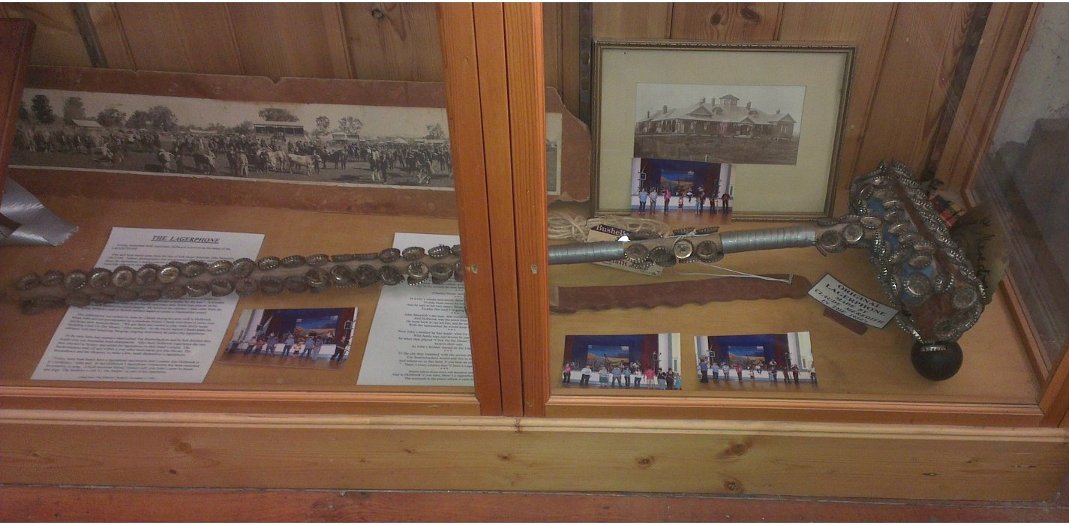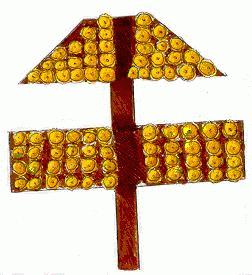When I first started researching lagerphones I got vague verbal stories - I could find little in print - about them having originated in the woolsheds of the Australian back country, sometime during the nineteenth century, as a complement to the bush base, also known as the tea chest base. I was always dubious about that idea and it now seems unlikely that they could have evolved until into the twentieth century. Apparently it being only about 1905 that there came into use in Australia the bottle tops (properly called 'crown seals') which are such an integral feature, they having been invented in the U.S.A. in 1892. Or at least lagerphones in their present form could not have been earlier, but Bob Bolton of the (Sydney)
has been telling me of four possible precursors - Chinese Pavilions, Jingling Johnnies, the Teufelsgeige or Devil's violin (an instrument traditional in germanic countries) and Turkish Crescents.
"The Turkish Crescent was a rhythm instrument of great antiquity in the Middle East. It consisted of an ornate stick with brass and silver bells that was played by shaking it in time with the music. It dates back as far as the 1300s and was an elaborate affair, often made of precious metals and adorned with gems. It played a prominent part in all their music, and was first adopted by military bands in the late 17th century. The British Army called it the Jingling Johnny and it was taken up by the popular military bands of the 19th century. The Jingling Johnnie consisted of a metal rod with two or three cross-pieces and a "pagoda" top - the lot covered with the jingles from tambourines, and shaken and beaten to provide rhythm. Its parentage may be traced back through Europe (where it has left branches of its family in many countries) to Turkey.
[But] my latest view supported by evidence of the instrument being found with Germanic immigrants and a 1910 photograph of a clearly home-made version being played with 'classical' instruments in a German musical group, is that the immediate ancestor [of the lagerphone] was the German Teufelsgeige (or 'devil's fiddle') aka the Czech Stumpfidel."
1
What has surprised me though is to find that the lagerphone as we know it today may date from as recently as the 1950's. The most persuasive - or at least the best documented - account I have yet found credits the concept to an itinerant rabbiter whose name, sadly, seems lost to history but who, in 1952, was camped at Lankey's Creek ten miles out from
Holbrook, NSW. Around that time 'Amateur Hours' were popular as fund-raisers and one such was organised by the Holbrook branch of the Red Cross Society. To it came our rabbiter friend with a broom handle to which he had loosely attached old bottle tops. He banged and rattled this to a piano accompaniment and earned himself a prize in the novelty section. Present at that concert was Claude Meredith, brother of the late
John Meredith, OAM. Claude was so intrigued by this idea that when he got back home he created a replica for himself and I now defer to John Meredith ('Merro' to everyone, incidentally) as to what happened next.
-------------------
"In this day and age, no self-respecting Bush Band would be seen - or heard - without its lagerphone. But it was not always thus. Forty-five years ago the now ubiquitous noise maker was unknown. In fact, before 1952 there wasn't even a bush band!
"That was the year I had a brilliant idea. I played the old traditional bush instrument called the button accordion, and my brain-wave was to con a couple of my mates, Brian and Jack, into joining me to form a group which would sing old bush songs to the accompaniment of the squeeze box, as it was affectionately called.
"Then Brian and I went on a visit to my family in my home town of
Holbrook. 'Come up to my place tonight', said my brother Claude. 'I've got a surprise for you. Bring your squeeze box'. In due course we arrived and I was ordered to play. 'Give us something lively', ordered big brother, going into the adjoining room. I swung into "Click Go the Shears" with Brian singing. Then there came this crashing, jingling, rhythmic sound as Claude marched in bouncing a strange looking instrument! It consisted of a bald-headed hair broom, they were made entirely of wood in those pre-plastic years, covered with loosely nailed-on bottle tops, which covered the head and most of the handle.
"As Claude bounced it along the floor to the down-beat, he alternately struck and sawed at the handle with a serrated waddy. Then he proudly pronounced those portentous words 'Introducing - The One and Only - Celebrated - Lagerphone!'.
"Excitedly we wrestled it away from him, or rather Brian did. My hands were strapped to the squeeze box. After a couple of tunes, we paused for another beer and the obvious question : 'Where in the hell did you get that from?' "
And Claude told them about the rabbiter.
-------------------
That lagerphone that Claude made (and the first one to be so-called) is now in the
Woolpack Museum at Holbrook.
The
original, the one the rabbiter made, has sadly disappeared with him.

Claude Meredith's lagerphone now lying in state in the Woolpack Museum. This picture was taken by my friend Gina Harrop when she stopped off in Holbrook one day. Unfortunately it could not be taken out for a stand-alone picture because the cabinet key has been mislaid and the museum staff knew not its whereabouts. So if someone reading these notes should just happen to be a locksmith and should likewise happen to be passing through Holbrook .......
Now that, as I say, is the best documented account I have so far found, but it does raise two obvious questions. First - why, if the precursors were known in the nineteenth century, and the critical bottle tops were available from the beginning of the twentieth century, did it take fifty years for the lagerphone to emerge? And second - whence did the rabbiter get his idea?
Could it in fact have been developed, albeit under a different name (or no name), or in different appearance, and then been forgotten? The success of the Meredith story was dependent on an element of chance - brother Claude being in the right place at the right time, and brother John being in the right position to develop it. If those chances had not juxtaposed the rabbiter's idea would also have been forgotten. Alan Scott mentioned meeting one old bushman who saw a lagerphone-type instrument in 1912. Bob Bolton has sent me one picture of the
Mehner's Orchestra taken at Wedderburn (on the Appin Road, south of Campbelltown, NSW) in 1910 in which "the group are largely players of 'classical/orchestral' instruments ... but the girl on the right has what is clearly a home-made Teufelsgeige",
1
and another of a
'Gazunkaphone' in his possession - '.... a replica instrument made by a bloke who saw it played (presumably by an Australian) in a Japanese prison camp in Indonesia' which Bob describes as having all the critical features of a lagerphone. And Garry Sullivan, former caretaker of the Woolpack Museum, remembers two West Australian visitors who thought something of the sort had been known over there before 1952.
And as regards the second, it could have been spontaneous, indeed most of the people who know that story seem to assume it was, but could he have picked up the idea from something or someone else? Possibly he could have because Pete West relates this to me :
"When I was a child in the 1950's I stayed for a while with my uncle Fred (Eastley) on his farm out at
Young. One day I remember finding in a shed and getting into strife for playing with, something that many years later I was introduced to by the Bush'n'Damper Band from
Tumut as a lagerphone. There were a couple of sorting and packing sheds connected by wood verandas and one day when I was in there I took a contraption down off the nail from which it was hanging by a hide thong, and was mucking around with it when Fred suddenly appeared, snatched it away from me and said 'that's me Johnny pole and you leave it alone!' That's how I learned it was called a Johnny pole. I didn't even know for certain it was a musical instrument, but I thought it must be something like that or a thing used in a circus. Anyway it stayed on the wall after that. Whether Fred had ever used (ie played) it, or if someone else did, we'll never know, but Fred obviously still valued it to judge from his reaction. It had beer bottle tops and a couple of molasses tin lids on it, and a horseshoe and its end had binding on."
Now pause the story at that point and think a bit.
Young is not far from
Holbrook , nor from
Gundagai where there was a dance band which Pete remembers being taken to hear. A rabbiter would have been itinerant and could easily have covered all that area. And Pete's uncle Fred was born about the turn of the century so if he was playing in his prime that could easily have been the nineteen thirties or forties - and he called his instrument a Johnny pole - and one of our possible precursors was called a Jingling Johnny - and, if I could allow myself a sideways jump, there were the johnny cakes about which we sometimes sing. The possibility is here of the missing link - that at least in this area of New South Wales dance bands were using something of the sort early last century and that our rabbiter friend picked up the idea.
So! The possibility that somewhere here might be the missing link! Or at least a lead to it. If anyone else should happen to remember Fred Eastley from Young or the Bush'n'Damper Band from Tumut, or indeed anything of bush music in that area in the first half of last century and could send me an email ........ (My letter box is on the Index page - see below.)









